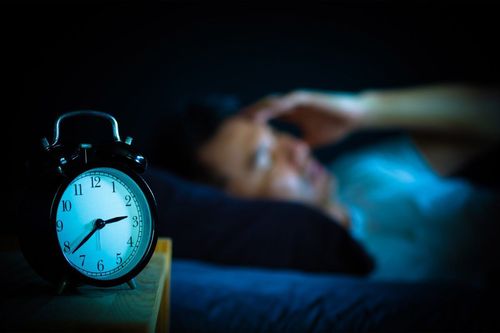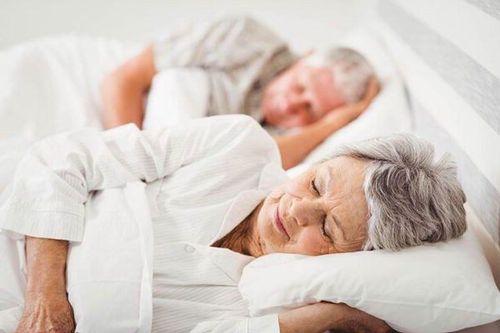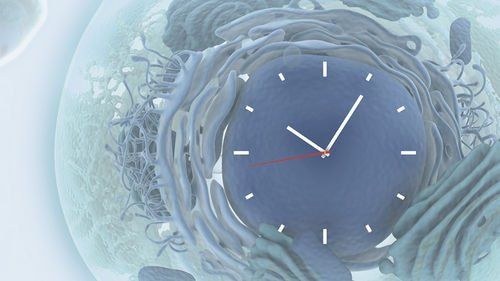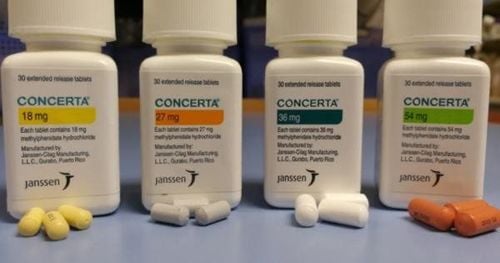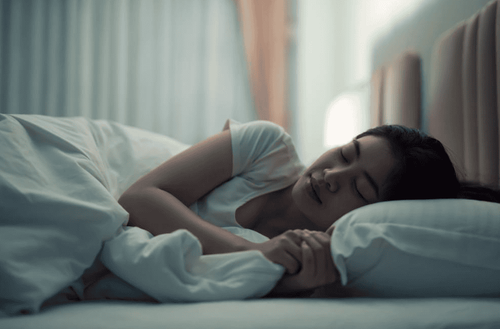This is an automatically translated article.
Circadian rhythm sleep disturbances are problems related to our circadian rhythms. The "internal clock" keeps our biological processes running in step. Our normal circadian rhythm is set by a 24-hour light and dark cycle. It plays an important role. important in how we sleep and when we are awake.1. What is circadian (Circadian) sleep disorder?
Disturbance of the sleep rhythm associated with difficulty falling asleep, waking up in a sleep cycle, or waking up too early and not being able to go back to sleep. Cyclic sleep disorders are a group of sleep disorders that are characterized by disrupted sleep duration. Circadian in Latin means "around or about a day". Circadian rhythm is the name given to our body's 24-hour "internal clock".
This watch helps control our body's sleep-wake cycle. What helps to “set” our internal clock is the visual cues of light – namely the brightness/type of light, amount of time exposed to light, and time of exposure to light. . Light is transmitted through our eyes and into a specific "control center" of the brain.
However, there are other factors that influence our internal clock, including melatonin (a hormone secreted in the brain that plays a role in sleep), physical activity, and social behavior. . Our age can also affect our sensitivity to the sleep-wake cycle.
Circadian rhythm sleep disorder associated with one of the following: Difficulty falling asleep; struggles to stay asleep and often wakes up several times during sleep cycles; woke up too early and couldn't go back to sleep.
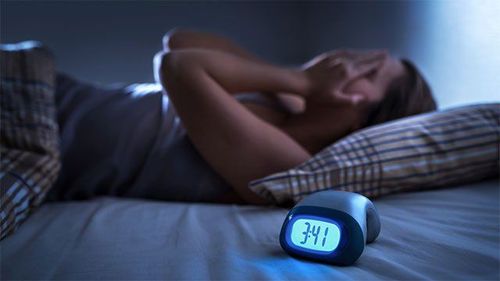
Hội chứng rối loạn giấc ngủ nhịp sinh học gây ra khó đi vào giấc ngủ
Advanced sleep phase disorder: If we have this sleep disorder, we will fall asleep early in the evening (6pm to 9pm). pm) and wake up early in the morning (2am to 5am). Other common features of advanced sleep phase disorders are: They often complain of early morning awakening or insomnia and late afternoon or early evening sleepiness. This type of disorder is most commonly seen in middle age and older adults. If we have this sleep disorder, our internal body clock may have been disturbed due to the time difference after moving from one location to another far away. This sleep-wake cycle disruption makes it difficult to adjust to and function in the new time zone. Traveling to the East countries is more difficult than traveling to the Western countries because it is often easier to delay sleep than to go to bed early. The general features of this phenomenon are: Altered appetite; changes in digestive function (stomach and intestines); tired; irritability or restlessness and mood disturbances.
Shift work sleep disorder: A person can get this sleep disorder if they frequently rotate shifts or work at night. These work schedules conflict with the body's natural circadian rhythms, making it difficult for us to adjust to that change. Shift work disorder is defined by a persistent or repetitive pattern of sleep disruptions that results in insomnia or excessive sleepiness.

Tăng ca làm việc có thể gây ra hội chứng rối loạn giấc ngủ nhịp sinh học
Irregular sleep-wake rhythm: This sleep disorder has an indeterminate sleep-wake cycle. We can get some sleep in a 24-hour period. Symptoms include persistent (chronic) insomnia, excessive sleepiness, or both. This disorder is more commonly seen in people with neurological conditions such as dementia, nursing home residents, children with intellectual disabilities, and in people with traumatic brain injury. Non-24-hour sleep-wake syndrome: If we have this sleep disorder, we keep our sleep and wake times the same but our "internal clock" is longer than 24 hours. Therefore, the actual sleep-wake cycle changes on a daily basis.
2. Causes of circadian rhythm sleep disorders, symptoms and treatment measures.
Circadian rhythm sleep disorders are caused by intermittent or infrequently disrupted sleep patterns. Disruption is the result of a malfunction in our “internal body clock” or a mismatch between the “internal body clock” and the external environment (e.g.: Social and work requirements ). This affects activity time and sleep time.
This circadian mismatch causes functioning problems at work, school, and social activities. Situations that can cause circadian rhythm sleep disturbances include: Frequent shifts in work, frequent changes in bedtime and wake times; people with brain damage due to medical conditions such as stroke, dementia, intellectual disability caused by head trauma; people who are blind or have not been exposed to sunlight for long periods of time; may be due to the side effects of some drugs;... Besides, older people are more likely to have sleep disorders.
Symptoms of circadian rhythm sleep disorders: Insomnia (difficulty falling asleep or staying asleep).
Too sleepy during the day.
Difficulty waking up in the morning.
Insomnia, depression.
Stress in relationships.
Poor work/school performance.
Inability to meet social obligations.

Ngủ ngày là biểu hiện của người đang mắc chứng rối loạn giấc ngủ nhịp sinh học
How is circadian rhythm sleep disorder diagnosed? Diagnosing a circadian rhythm sleep disorder can be difficult and often requires consultation with a sleep specialist. Your healthcare professional will collect information about your patient's sleep history and work schedule and ask them to keep a sleep diary for one to two weeks. The sleep specialist will also rule out other medical and sleep disorders such as narcolepsy, which often resembles a later sleep phase disorder. A sleep diary is often used in conjunction with a watch-like device (called an activity recorder) that records sleep and wake activity over a period of one day to one week. Sleep studies are tailored to address individual sleep patterns.
How is circadian rhythm sleep disorder treated? Treatment options for circadian rhythm sleep disorders vary depending on the type of disorder and the extent to which it affects our quality of life. A sleep specialist will develop a personalized treatment plan that improves the patient's chances of success. Most treatment plans require a combination of approaches. Treatment options include:
Behavioral and lifestyle therapy: This approach encourages changes to improve sleep and develop good sleep habits. Good sleep habits include maintaining a regular sleep-wake time (even on weekends and vacations); avoid napping (exception: Shift workers); develop a regular exercise routine (avoid intense exercise within an hour of bedtime); Avoid alcohol, caffeine, nicotine, and stimulant activities within a few hours of bedtime. Glare therapy: Glare therapy is used to promote or delay sleep. The timing of this treatment is very important and requires the guidance of a sleep specialist. Glare therapy works by resetting the circadian clock to be more in sync with the Earth's light and dark cycles. High intensity light (2,000 to 9,500 lux) is required, and exposure duration and duration varies from one to two hours. Exposure to bright light in the morning can help people if they have a late night sleep disorder. Patients should also reduce evening and nighttime light exposure by reducing indoor lighting; Avoid looking at a bright TV or computer screen. Exposure to bright light in the evening can be helpful if we have a deep sleep disorder.
Medications: Medications such as melatonin (over-the-counter), drugs that promote alertness (such as modafinil - Provigil) or caffeine, and short-term sleep aids can be used to regulate and maintain the sleep cycle. - wake up to the desired schedule. Tasimelteon (Hetlioz) is approved for the treatment of a wakefulness disorder that does not last 24 hours. Chronotherapy: This therapy uses either increased or delayed sleep duration (three hours every two days) depending on the type and severity of the disorder. This type of therapy requires a firm commitment from the specialist and the patient as it can take several weeks for a successful sleep-wake cycle change. Once the desired schedule is achieved, the patient must maintain this regular sleep-wake schedule. Circadian rhythm sleep disorders are caused by intermittent or infrequently disrupted sleep patterns. There are many forms of circadian sleep disorders, each with its own unique characteristics. Treatment is based on the type of sleep disorder we have and how it affects our quality of life.
Please follow the website: Vinmec.com regularly to update many other useful information.
Please dial HOTLINE for more information or register for an appointment HERE. Download MyVinmec app to make appointments faster and to manage your bookings easily.
References: my.clevelandclinic.org, aasm.org, msdmanuals.com




